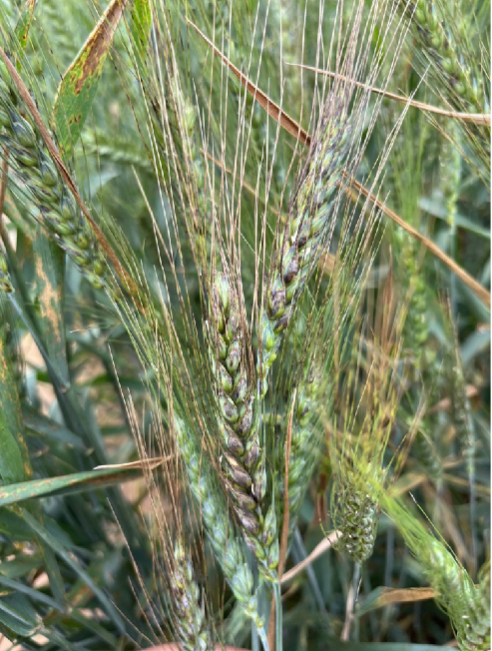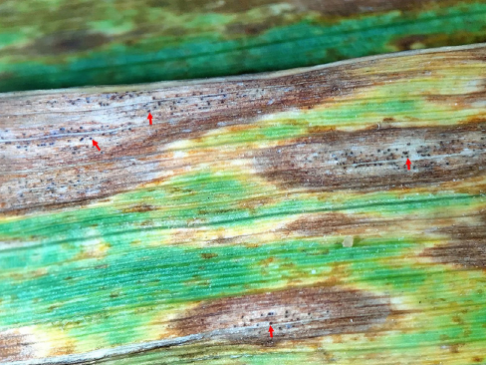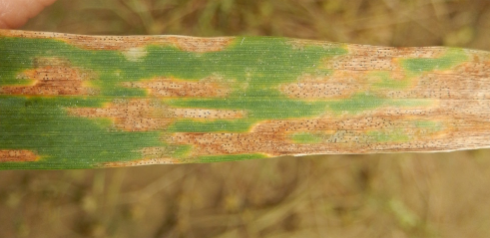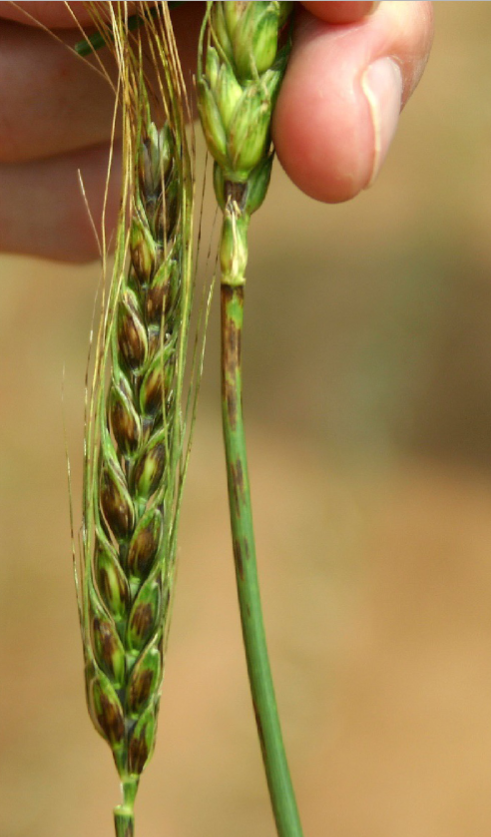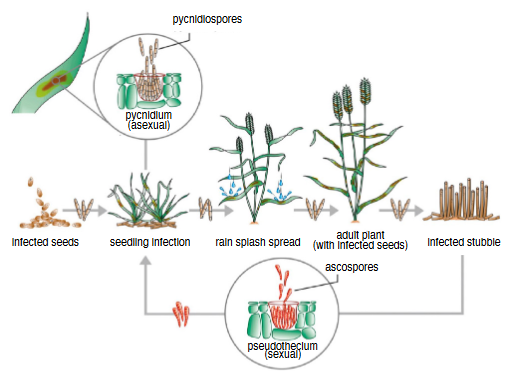Septoria Nodorum Blotch: A New Challenge to Wheat Production in Oklahoma
Septoria nodorum blotch (SNB) of wheat is caused by the fungus Parastagonospora nodorum (formerly named Stagonospora nodorum, Septoria nodorum). SNB occurs in wheat-growing areas worldwide, where warm and moist weather is prevalent, such as the eastern United States, parts of northern Europe, Australia and parts of North Asia. SNB is manifested as a leaf blotch and glume blotch complex, and it can reduce both yield and grain quality (reduced seed size and test weight). The fungus can infect wheat during seedling and adult plant stages. All aboveground plant parts can be infected including leaves, leaf sheaths, stems, glumes and awns. SNB yield losses of up to 50% have been reported on susceptible cultivars; however, losses are usually lower in the U.S. In Oklahoma, SNB is becoming more prevalent in recent years, occurring in four out of the last five years (2019 - 2023). Farming practices that leave more crop residue on the soil surface, such as minimum/no tillage, could promote SNB incidence and severity. A recent study of P. nodorum isolates collected from multiple wheat growing regions in the U.S. showed Oklahoma isolates have high genetic and virulence diversity. This diversity enables robust adaptation to wheat cultivars in Oklahoma.
Symptoms and Signs
Symptoms first appear as small dark-brown to chocolate-colored lesions on the lower leaves. These lesions usually have a yellow halo caused by toxins that are produced by the fungus (Figure 1). As the lesions expand, they become elliptical in shape with dark-brown centers. Mature SNB lesions have grayish-white centers with dark-brown margins. Lesions on the leaves can coalesce to cover a large portion of the leaf surface, resulting in death of leaf tissue. On the glumes, symptoms appear as brownish-gray lesions (Figure 2). Infected glumes result in reduced seed set and shriveled kernels, thus reducing test weight. Stems can also be infected, exhibiting dark-brown lesions especially at the nodes, and thus the species name "nodorum."
Figure 1. Septoria nodorum blotch on leaves (Morris, Okmulgee County, Oklahoma, May 16, 2023).
Figure 2. Septoria nodorum blotch on glumes and awns of the wheat cultivar "Breadbox" (Stillwater, Payne County, Oklahoma, May 17, 2023).
On mature SNB lesions and under high humidity, P. nodorum forms asexual fruiting structures that are difficult to see without magnification (160 – 210 μm in diameter) called pycnidia (Figure 3). Under high moisture, pycnidia exude asexual spores known as conidia or pycnidiospores in pink gelatinous masses. Conidia will infect other plant tissues if the weather is conducive. This fungus overwinters on wheat residue until the next season using sexual structures called pseudothecia that contain ascospores (sexual spores) and pycnidia (asexual structures). Sexual reproduction introduces genetic diversity in the fungus population, thus enhancing its ability to overcome management measures, including resistance in wheat.
SNB symptoms on the leaves can be confused with those of Septoria tritici blotch (STB), especially because both diseases can affect the same plant simultaneously. Unlike SNB, STB lesions are rectangular in shape because they are delimited by leaf veins. In addition, pycnidia produced by the STB fungus are more abundant and easier to see with unassisted magnification (Figure 4). STB is more prevalent under cool temperatures (50-68°F; 10-20°C), whereas SNB is more prevalent under warmer temperatures (68-81°F; 20-27°C). SNB symptoms on the glumes can be confused with black chaff symptoms caused by the bacterium Xan-thomonas translucens pv. undulosa. However, black chaff symptoms on the glumes and awns appear as dark purple to black streaks (Figure 5), and bacterial exudate (ooze) can be observed.
Figure 3. Pycnidia of Parastagonospora nodorum observed under a dissecting scope (12 × magnification) (Courtesy: U. Adhikari).
Figure 4. Septoria tritici blotch on wheat leaf. Black specks on the lesions indicate pycnidia.
Disease Cycle
The primary inoculum of P. nodorum is usually asco-spores originating from infected wheat residues, although the pathogen also can be seed transmitted. Ascospores can be disseminated by wind to adjacent fields. Once the fungus has established the initial infection, large amounts of pycnidiospores (secondary inoculum) can be produced within 10 to 20 days and dispersed by rain splash from lower leaves to upper leaves and glumes and adjacent plants (Figure 6). Moderately warm weather (68-81°F; 20-27°C) and frequent rainfall are optimal for the development of SNB.
Disease Management
Cultural practices. SNB can be managed using crop rotation and tillage that ensures complete burial of wheat residue. However, crop rotation and tillage are not widely practiced in Oklahoma. Destroying volunteer wheat and wild grasses that can act as alternative hosts may reduce the spread of SNB.
Figure 5. Symptoms of black chaff (Courtesy J. Edwards).
infected with SNB fungus, seed treatment with fungicides can be used to reduce primary inoculum in the field. Aframe (azoxystrobin) or Aframe Plus (azoxystrobin plus propicon-azole) can be used as seed treatments to manage SNB. Multiple foliar fungicides are available to effectively manage SNB in the spring, including strobilurins (picoxystrobin, pyraclostrobin and azoxystrobin), triazoles (metaconazole, prothioconazole and propiconazole) and mixed mode of action fungicides (e.g., trifloxystrobin + prothioconazole, pydiflumetofen + propiconazole, fluxapyroxad + pyraclos-trobin, prothioconazole + tebuconazole + fluopyram, etc). Details on the efficacy of foliar fungicides in controlling SNB can be found at Crop Protection Network.
Figure 6. Disease cycle of Septoria nodorum blotch (Downie et al., 2021).
Host resistance. The U.S. Department of Agriculture – Agricultural Research Service coordinates annual SNB field evaluations of advanced breeding lines from central and eastern U.S. breeding programs. The evaluations identified soft winter wheat cultivars with partial resistance to SNB. Further, five SNB sensitivity (susceptibility) genes have been characterized in wheat including Tsn1, Snn1, Snn3-B1, Snn3-D1 and Snn5. However, effective diagnostic markers to select against these sensitivity genes are currently available for only Tsn1 and Snn1. There is sparse information about resistance levels to SNB in hard winter wheat from the Southern Great Plains. The sensitivity gene Tsn1 is prevalent in Oklahoma and Southern Great Plains hard winter wheat cultivars. This gene results in susceptibility not only to SNB but also to tan spot and spot blotch. OSU cultivars "Gallagher," "Paradox" and "Breadbox" are highly susceptible, while "Big Country" and "Uncharted" are resistant. As widespread SNB symptoms were observed in Oklahoma in recent years, seedling evaluations in the greenhouse and field evaluations are ongoing to identify levels of resistance/suscepti-bility in OSU wheat cultivars and breeding lines.


